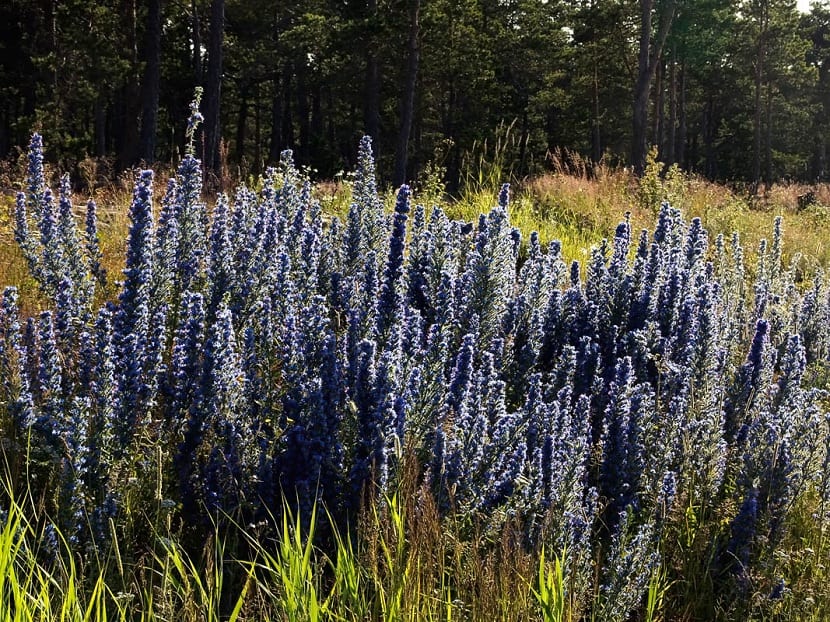
Today we are talking about a plant known by several common names and that resembles the head of a viper. It's about the viborera. It is a plant quite known in ancient times because it was believed to be a remedy against snake bites. Its scientific name is echium vulgare and it is known by other common names such as bugloss, ox tongue, cerruda grass and cimarrona bojarra.
In this article you can find everything about its characteristics and properties.
Key features

The main common name of this plant It is due to its resemblance to the head of a viper. The ox tongue refers to its roughness. As they have hairs, the contact when touching them resembles the texture of the ox's tongue.
It is a biannual plant that has an average length between 40 and 80 centimeters. The characteristic that makes it different from other types of plant is its stem. And it is that it is covered with a kind of sticky hair with a rougher and quite thick texture.
Its leaves are quite elongated as if they resembled a spear. They are of the sessile type. The mixture of flowers and leaves is what makes it look like the head of a viper. The flowers when they come out, have a purple color and as they develop, they take on a more blue or violet hue. This is a perfect indicator of the stage of growth in which it is. His signature is tubular and is expanding to the extreme.
It usually gives the most similar touch to a viper when inside the flowers You can see up to 5 stamens longer than the corolla and protruding, looking like the tongue of the viper. The flowering season takes place in the months of June and July.
As for the fruit, it is an achene with 4 seeds inside.
Habitat and collection

This plant has its habitat on the edges of roads and highways. Its seeds spread and grow spontaneously in these places. It is usually accompanied by other plants that are considered anthropized vegetation. The appearance of this type of "humanized" plants is due to the presence of huge amounts of organic waste from agriculture and livestock.
Since these lands are modified by humans to carry out various agricultural tasks, they have dirt roads for the transit of machinery, vehicles or as trails. Normally the echium vulgare It usually appears in these areas and feeds on the organic remains of these activities.
Regarding its distribution area, we find large areas throughout the world. They extend from Europe to Asia, through America and North Africa. In all these places it is usually found on these roads of agricultural land colonizing it along with other ruderal plants.
To collect this plant, it is important to do it before flowering or shortly after starting it. Since the month of April they are already prepared and ready to be collected and preserved. The parts that are most used of this plant for various uses that we will see below are the flowers, as part of medicinal uses and the tender leaves that are used for some salads.
Uses of echium vulgare

As we have mentioned before, many people use its fresh leaves to compose some delicious and nutritious salads. Nevertheless, old sheets cannot be used. They are usually high in pyrrolizidine alkaloids and this makes their consumption dangerous. Before adding the leaves of the viborera in a salad, it is better to make sure that it is fresh and in good condition.
As for the its flowers are used in herbal medicine. The most common cases for which it is not recommended to use this plant for medicinal purposes are in those who have liver diseases. This occurs because its high alkaloid content can cause toxic effects on this organ and worsen the problems instead of treating them.
The flowers are rich in mucilage and can be used in infusions with diuretic, pectoral, healing and emollient effects. The first is its purifying use. It is a plant that has alkaloids that have great diuretic properties. Fluid retention is very common in patients with obesity or a high carbohydrate intake. Therefore, the infusions with the flowers of the echium vulgare They are used to treat people with obesity and rheumatic pain.
Another use is for pectoral treatments. Its leaves and flowers have a high content of mucilages that have demulcent properties. Therefore, the infusions are perfect for treating coughs and bronchitis by acting as an expectorant. It is also used to gargle against a sore throat.
External remedies of the viborera

It also has external medicinal uses. It is high in allantoin. It is a substance that has been used for a long time for the composition of different types of cosmetic creams and ointments thanks to its healing, regenerative and rejuvenating properties of the skin. The good thing about it is that they mix these effects with those of mucilages and tannins to enhance their effect.
Among its external uses we find its emollient property. Since it has this effect in plasters, it serves to soften the parts of our body that are irritated and helps heal some wounds.
The oil in the seeds of the viborera is rich in omega 3 fatty acids. More specifically, it has steanidonic acid. This oil is perfect for anti-inflammatory treatments and to treat acne, eczema and improve the appearance of the skin. Its rejuvenating properties help improve the quality of the skin.
It was formerly thought to have magical properties. By its appearance of the head of a viper, It was thought to have properties to heal the bite of the same. However, as time passed, this was shown to be wrong.
I hope this information helps you to know more about the Echium vulgare.